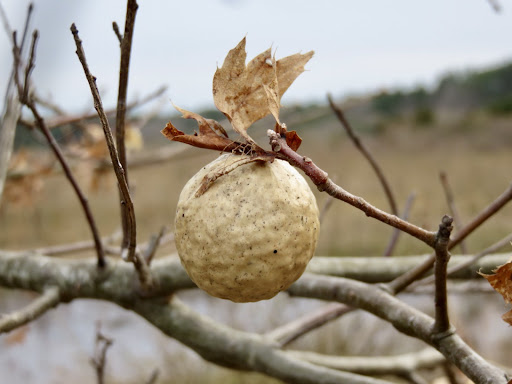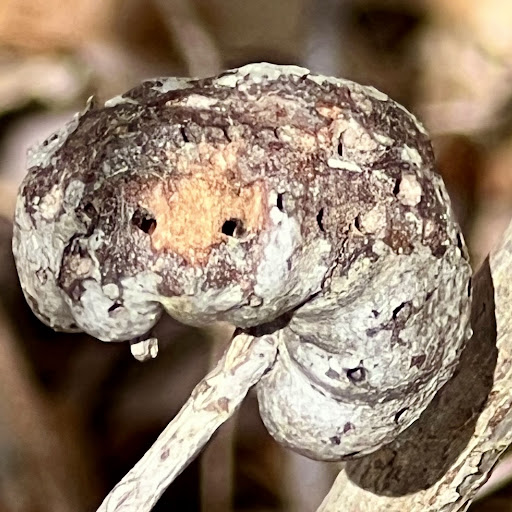I regret to say that no one correctly identified last week’s “What Is It!”. Guesses included a slug and a fossilized caterpillar. Nice try, but . . . . Let’s take a second look.

The subject of this closeup photo is a one-inch object. Here it is in the context of our reader’s backyard.

This is an odd object but not a rare one. As you can see, it is attached to a shrub, to be precise, a highbush blueberry. Indeed, integrated might be a better word than attached, for the object is made of plant matter. Nevertheless, the readers who guessed an animal origin were not far off the mark. A tiny wasp initiated this abnormal growth by laying its eggs under the surface of a young shoot. The eggs hatched, the larvae fed, and the plant cells responded to these injuries, and to chemicals produced by the larvae, by forming a distinctive blueberry stem gall. This swelling provided food and shelter to the developing insects.
Britannica defines a gall as “an abnormal, localized outgrowth or swelling of plant tissue caused by infection from bacteria, fungi, viruses, and nematodes or irritation by insects and mites.” With so many possible causal agents, it’s not surprising that gall diversity is immense. Smithsonian’s article, “Insect and Mite Galls,” claims that
“Nearly 1,500 insect species in the U.S. produce galls” including 800 species that feed on oaks. One of those insects, another gall wasp, creates a large gall that is conspicuous in Massachusetts’ forests. You may already know the lightweight, ping-pong balls called oak apples.

Observing the variety of gall forms is fascinating. Each gall insect chooses a specific plant species, and often a particular part of the plant such as the leaves or the buds, on which to deposit its eggs. Once you learn the gall shape and its host plant, you can find that gall insect’s work over and over again. Hopefully, in a later post, I’ll introduce you to some of my favorites.
Let’s dig a little deeper into our gall-of-the-day. The adult blueberry stem gall wasp is a tiny creature, only 2 - 3 millimeters long according to a Michigan State University factsheet on the subject. That’s less than one tenth of an inch. I have not knowingly seen one, but the time to look in Massachusetts would be May, when blueberry bushes are flowering. That is when the adults chew their way out of the gall, look for mates, and lay eggs. Note the exit holes in this enlarged image.

Once the eggs hatch, the larvae develop and overwinter in the gall. Pupation occurs in spring. If you are curious, this same factsheet includes photos of an adult and larval gall wasp.
The galls themselves are far easier to observe than the wasps who create them. The first step is to learn how to recoginize blueberry bushes, either highbush or lowbush, whether or not they are in fruit! A good print or online field guide will get you started. Then, look for kidney-shaped growths on the stems. Initially, these will be green or reddish-green swellings. In time, they become hard, grey, and woody. The Maryland Biodiversity Project has a page with many images of this gall in different stages of development. Take a look.
You may be wondering how much harm these insects cause the shrub. After all, the stem that has been deformed by a gall will not flower or fruit. Indeed, the female wasp not only lays her eggs on the stem, she also stabs the branch tip with her ovipositor to prevent further growth. [See Naturally Curious with Mary Holland.] This means fewer blueberries. From my experience as a woods walker, these galls are common but not enough to overwhelm individual plants. The blueberry stem gall larvae are apparently parasitized by other wasps, and birds and mammals are said to prey on them as well. In cultivation, however, these galls have become problematic, especially when insecticides kill the parasites that would naturally keep their population in check. The prime recommendation from Michigan State and other agricultural sites is to prune the galls and dispose of them (as in burning). Or, if possible, plant resistant blueberry cultivars that won’t be attractive to the wasps. When neither of these approaches is feasible in a commercial operation, pesticide applications must be timed to avoid harm to the beneficial parasites.
Just imagine, the next time you are walking among blueberry bushes, you can wow your friends by pointing out these galls. You just need the right kind of friends!
Are you ready for the next game? Here are two new “What Is It!” challenges. First, an image:

Then a sound recording:
As always, submit your identifications to lrubinacci@amesfreelibrary.org and check back next week.